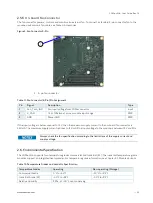
COMe-cEL6 - User Guide, Rev.1.3
// 39
3.4.
Fast I2C
The fast I2C bus transfers data between components data transfers at up to 400 kHz clock speed.
The I2C controller supports:
Multimaster transfers
Clock stretching
Collision detection
Interruption on completion of an operation
To change the I2C bus speed, in the BIOS setup menu select:
Advanced>Miscellaneous>I2C Speed> 400 kHz to 1 kHz
The default speed is 200 kHz.
3.5.
GPIO
The eight GPIO pins support four inputs pins (A54 for GPI0, A63 for GPI1, A67 for GPI2 and A85 for GPI3) and four
output pins (A93 for GPO0, B54 for GPO1, B57 for GPO2 and B63 for GPO3) by default. The four GPI [0-3] pins are pulled
high with a pull-up resistor (e.g. 100 K ohms) and the four GPO [0-3] pins are pulled low with a pull-down resistor
(e.g. 100 K ohms) on the module.
To change the default GPIO signal-state users are required to make BIOS and/or OS-driver changes, and additional
hardware changes by adding external termination resistors on the carrier board to override the weak on-module
pull-up resistors with a lower resistance pull-down (e.g. 10 K ohms), or pull-down resistors with a lower resistance
pull-up (e.g. 10 K ohms).
Configuration must be performed using the OS driver.
3.6.
Hardware Monitor (HWM)
The Hardware Monitor (HWM) Nuvoton NCT7802Y controls the health of the module by monitoring critical aspects
such as the module’s processor temperature using thermal resistors, power supply voltages and fan speed for
cooling.
The SMART FAN ™ technology controls the duty cycle of the fan output (FAN_PWMOUT) with temperature setting
points. This enables flexible fan control for cooling solutions and noise sensitive solutions. For system protection,
users can set threshold values for alarm signals.
The HWM is accessible via the System Management (SM) Bus address 5Ch, see Chapter 4.2: System Management
(SM) Bus. The HWM is controlled by the BIOS Advanced setup menu:
Advanced> H/W Monitor>
and has no OS
support.
The HWM Bus address is 5Ch.
















































